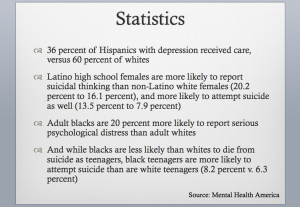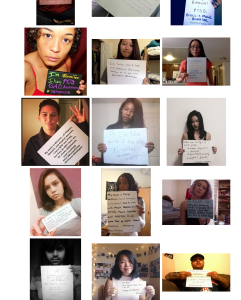
Latina mental health was front and center for a change thanks to Smith College alum Dior Vargas ’09. The Latina feminist mental health activist and recipient of the White House Champion of Change for Disability Advocacy, presented insights about mental illness/health and race. Her clarion call was to all Latinas and People of Color (POC) to step out of the shadows. She also wants the rest of us to wake up about this issue. The Smith College NYC Club event was held at UJA-Federation of New York.
Silenced no more – Dior opened her talk with personal stories.
“My mother slapped me when I first shared thoughts of suicide as a child,” said Vargas. “Therapy is for white people,” another relative told her. But Dior refused to be silenced.
“White criminals are considered mentally ill. But People of Color are treated like a criminals before considering that they might have a mental illness. Latins and People of Color battle microaggressions, cultural, religious, language barriers, and negative stereotypes that white people rarely face,” said Vargas.

Brown, Black pain – How many of you know or are related to someone with a mental illness? Do you know someone who needs therapy, counseling and treatment because of stress, grief, or depression? Would you call the police if your schizophrenic or bipolar child or relative attacked you? Are you in denial about your loved one’s pain? Does brown and black pain exist? Dior confronts these topics and more in her advocacy work. Her pioneering People of Color Mental Illness photography project, successfully funded on Kickstarter, is expanding globally.
Complex cultural stigmas, access to treatment and culturally sensitive services are big problems. Finding the right doctor, therapist, medicine, diagnosis and treatment add up to more challenges. We all know that racism and discrimination drives everyone crazy! But institutional racism against people of color in the medical, educational, police and justice system is rampant. Our own families, friends and communities are also part of the problem too.
Smith College alums, friends and family gathered to learn and listen. We engaged in dialogue about this invisible problem.
Comments from Smithies
How we talk and don’t talk – “Dior Vargas ’09 bravely shared her story and emboldened all of us to examine mental illness in our culture and in society, how we talk about it or don’t talk about it: the ingrained shame or taboo about mental illness, whether in the home, in schools, in our communities, the intersection of race, class, geography, ancestral memory, and identity as it relates to health, wholeness, mental illness as a disability, and resilience. Dior seamlessly integrated startling statistics, her own story, and powerful examples of her Photo Project, galvanizing people all over the world to share their truth via a supportive online community.
Dior is an activist, feminist, and mental health pioneer. It was a privilege to hear her. I feel like we were watching greatness unfold, as she is just starting out. I’m so proud of Dior and our Smith community who supported her on January 26 evening, with alumnae from both Smith College and The Smith College School of Social Work and friends of Smithies.” Vanessa Gates-Elston, NYC Smith Club, VP Programs

From invisible to visible – “I have been involved for many years with NYC-based Fountain House, the leading successful community mental health recovery model that has inspired development of similar Clubhouses – working communities – in 32 countries worldwide.
I was so moved by Dior, who shared her personal story of living with depression. She spoke about her long history of struggling with unbearable suffering – leading to suicide attempts to escape the pain. Stigma, lack of knowledge about mental illness and cultural norms in the Hispanic community led to her family’s inability to accept and communicate about her depression, leaving her devastated and socially isolated.
Dior’s commitment to speaking out about her personal journey touched everyone. She shared little-known statistics about the stigma and social distancing experienced by Black and Hispanic people living with mental illness that revealed they are largely invisible in society.
Seeking to change the media’s focus on mental illness as a “white person’s disease,” Dior created the inspiring People of Color Photo Project. Black, Hispanic and other People of Color post photos of themselves holding posters revealing their illnesses and celebrating their own strength and resilience. Invisible no longer, they stand as a model for others in their communities, calling for greater awareness and conversations about mental illness that can reduce stigma and encourage people to seek treatment leading to recovery.
Dior’s hard-won courage to speak out and her commitment to changing the way people of color with mental illness are perceived and treated by their families, communities and the media is ground-breaking and will make a real difference. Encouraging all other Smithies to support this amazing Project, I remain changed by Dior’s compelling personal story and her resounding call to action. Karen Pratt ’76, Fountain House, NYC.
Latina affirms – “As a Latina woman, I could relate to Dior’s presentation. Hispanic-Latin families are very close-knit, and therapy/counseling is not part of the culture nor is it accepted as essential to our well-being. Some change has happened, though very slow. Social media is helping to improve awareness of mental health in Hispanic/Latin communities. Doors are opening to communication among families with children with emotional challenges. Yet, more education and awareness about mental illness is needed to continue via social media, TV, radio and all avenues of communication in order to reduce the immense stigma embedded in the community.” Jennifer Rivera, Fountain House, NYC.
Make personal political; be an ally – “Ms. Vargas is an inspiration. She eloquently and courageously disclosed details of her journey living with mental illness. In the spirit of feminists before her, she made the personal political. She wove theories of intersectionality of race, gender, and sexual orientation. She advocated for policy and cultural changes to address health care. She challenged us to examine the ways stigma affects all of us, particularly people of color.
As allies, it can be an overwhelming task to figure out what we can do to join and follow Ms. Vargas’ charge. As she modeled for us, it can be easiest to start with the personal, by identifying and examining our personal beliefs about mental health care and mental illness.
Common myths and misunderstandings about therapy and mental health problems:
If I have mental health conditions, I am weak/bad.
If I need help, I am weak/less of a man.
If my child has mental illness, it means I am a bad parent.
I should keep my illness a secret/in the family.
I should be able to handle this on my own/ with the church’s help only/with my family’s help only.
If people were to learn about my issues, they will all judge me and I will lose my job (insert other negative consequence).
You can ask yourself and loved ones these questions and work to challenge the ones that are untrue, or unfair to yourself and others:
Do I judge people for going to therapy or seeking counseling? Do I think about those in therapy in stereotyped ways? Have I internalized stigmas? Do I worry that I will be judged and/or discriminated against for my mental health issues? “ Wendy Bassett, LCSW, AC’98, MSW ’03, Psychotherapist
What are your thoughts on how can we improve the mental health crisis for people of color?
I really don’t know what to do. But I try to educate myself as POC talk more openly about their struggle. I know certainly from growing up that mental illness was sort of recognized and accepted as some God-given challenge. Family simply acknowledged it as the way things were. But they did not address. Thank you for sharing this enlightening post.
Although mental health issues go largely undiagnosed and untreated in “general” population, this highlights many of the issues that impact persons of color more severely. Stigmas about going to treatment – coupled with often inadequate and/or culturally ignorant treatment – make it necessary for persons of color to become more aware of the impact of mental health issues on individuals, our communities and the country. A well done piece and a needed call for activism.
Great read Cookie! I appreciated Dior’s advice on being an advocate for friends and family living with mental health diagnosis’ and her highlights of the shaming systems that often silence the voice of women and people of color in society. I look forward to more folks joining the dialogue as clients, therapists and allies. Thank you for sharing- Smithies rule! xx